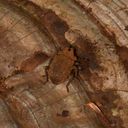Bolitotherus
Bolitotherus
Classification
- Phylum: Arthropoda
- Subphylum: Hexapoda
- Class: Insecta
- Order: Coleoptera
- Suborder: Polyphaga
- Superfamily: Tenebrionoidea
- Family: Tenebrionidae
- Subfamily: Tenebrioninae
- Tribe: Bolitophagini
- Genus: Bolitotherus
Pronunciation
How to pronounce Bolitotherus: /bɔˌlɪtoʊˈθɪrəs/
These audio files are automatically generated. While they are not always 100% accurate, they are a good starting point.
Images





Summary
Bolitotherus cornutus, known as the horned fungus beetle, is notable for its association with Ganoderma fungi, its unique horned males, and specialized mating behaviors linked to fungal availability.
Physical Characteristics
Adults are brown, armored beetles, 10–12 mm (0.4–0.5 in) long. Males have two sets of horns, while females lack horns. Males have a continuous range of horn and body sizes.
Identification Tips
Males can be identified by their distinct two sets of horns, while females are hornless. Coloration is typically dark brown and they have a sturdy, armored appearance.
Habitat
Habitat is associated with wood-decaying shelf fungi, particularly of the Ganoderma genus. They can be found beneath the bark of trees, decaying trees, and stumps, as well as directly on their host fungus.
Distribution
Found primarily in eastern North America, ranging from Canada to Florida.
Diet
Almost exclusively consumes the fungi of the Ganoderma family. Adults may consume other materials, but larvae prefer their egg and the fungus.
Life Cycle
The life cycle includes egg (laying usually occurs from June to August), larval, pupal, and adult stages. There are generally two brood groups influenced by when eggs are laid, with a potential life span of up to 8 years.
Reproduction
Lays eggs in clutches of one or in small groups, with a typical season yield of 8-12 eggs. Courtship involves males gripping females; post-mating, males mate guard females.
Predators
Predated upon by rodents (such as pocket mice and ground squirrels) and parasitic wasps (Eubadizon orchesiae) that exploit their eggs and larvae. Also affected by parasitic fungi like Fomes applanatus.
Ecosystem Role
Acts as a decomposer by consuming shelf fungi, thus facilitating nutrient cycling in forest ecosystems.
Collecting Methods
- Gathering from beneath host fungi
- Searching under decaying substrates
Preservation Methods
- Preservation in alcohol
- Drying specimens
Evolution
Belongs to the family Tenebrionidae, exhibiting sexual dimorphism in horn development, a trait under direct sexual selection.
Similar Taxa
- Other species of darkling beetles
- Ganoderma mushrooms
Misconceptions
Often confused with other darkling beetles that do not have the distinct horns of males or associated fungus-dependence behavior.
Tags
- Bolitotherus
- horned fungus beetle
- tenebrionidae
- darkling beetles
- Ganoderma